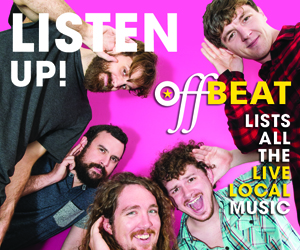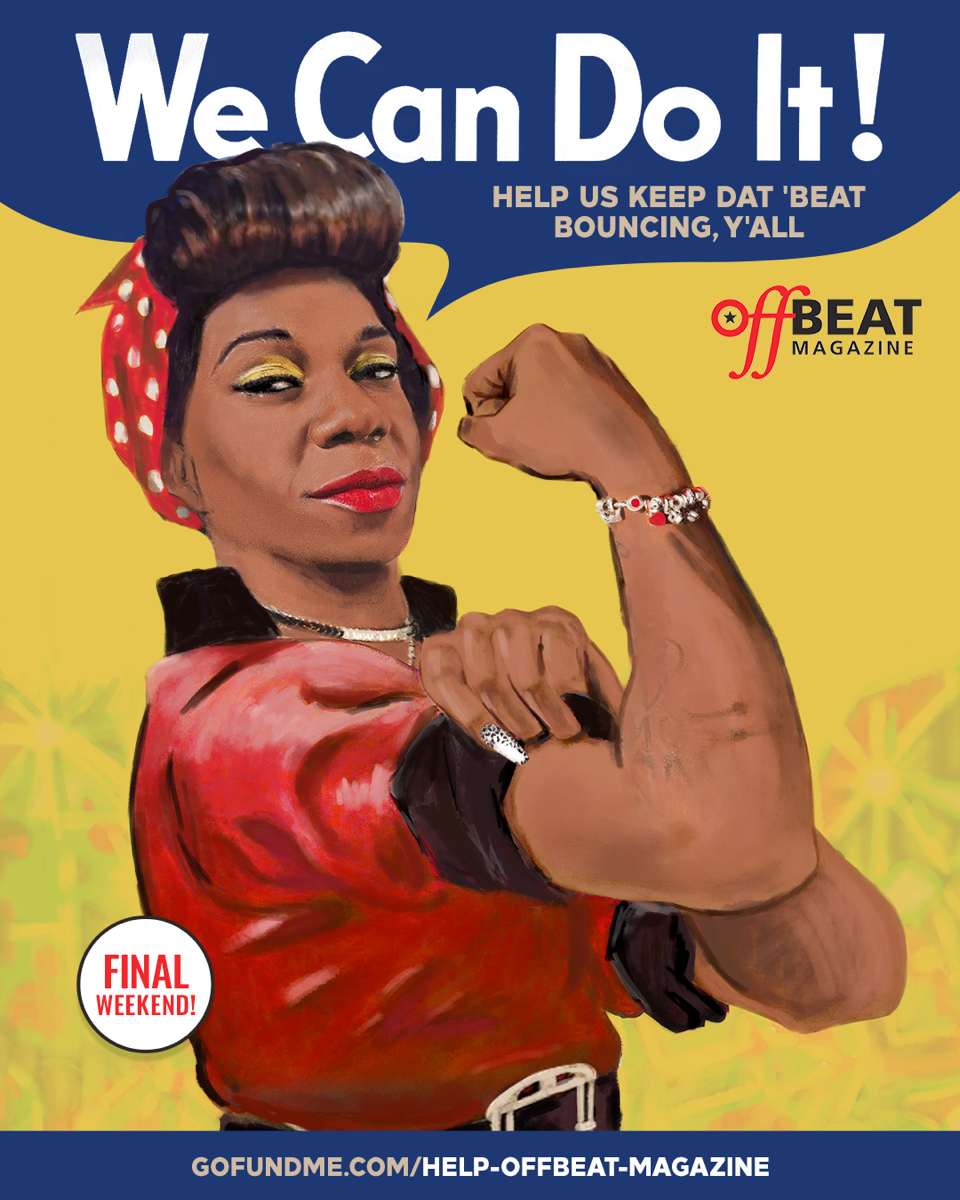ALIENATING FUTURE GENERATIONS
In the late ’80s I got re-interested in the New Orleans music scene for various reasons. Great new releases from the Neville Brothers (Yellow Moon), the Dirty Dozen (Voodoo on major label CBS), ReBirth and Buckwheat Zydeco combined with my first visit to Jazz Fest in 1989. It seemed like a resurgence was happening in New Orleans music. As the ’90s moved on, the music scene continued to grow, especially during Jazz Fest with Superfly producing interesting night time shows. Many young people came to town just to hit the clubs after dark. Jazz Fest got bigger each year and more musicians, young and old started getting involved mixing and matching different styles and genres of music. Bands such as Iris May Tango, the Soul Rebels, the Flavor Kings, Kermit Ruffins, All That, Coolbone, Smilin’ Myron, Beau Jocque and the Bluerunners to name a few were trying to move the sounds of Louisiana music forward and make it more interesting and fun.
That seems like a long time ago! Jazz Fest and the live music scene have become very stale! You would think the progression of music stopped in the ’70s. I was just reading a Times-Picayune article on line about Jazz Fest getting a new producer. That move is long overdue! Most people I know, young and old find Jazz Fest boring and stale. I am 45-years-old and my last trip to the fest two years ago was a non event (except for the food). I think it peaked in the mid ’90s. Quint Davis is completely out of touch with what people want to see. And getting lame bands like Phish, Dave Mathews, Widespread Panic and Lenny Kravitz was never the right direction! The Fest got too big for its own good. How about more interesting JAZZ! That is the name of the festival: JAZZ Fest.
This great festival is in danger of alienating future generations of Festival attendees unless it gets its act together! I moved to New Orleans in 1995 and planned on spending the rest of my life there. After five years, I became so bored with the nightlife and music scene I hardly ever went out at night unless an interesting band came into town which was a rarity. Anyway, I moved back to New York and I come down for my music/food fix once or twice a year. I miss the city but I get to see way way more music including my New Orleans faves in NYC.
—James Temple, New York, NY
BIGGER DOES NOT MAKE BETTER
As I sit here in my leaf changing soon to be snowing Vermont office I realize we are a short 226 days away from another all time great American experience, Jazz Fest 2005. I would like to relax and share a moment of euphoric post-romantic bliss. A short reflection on the great, great experiences of the past dozen Fests or so (I am still a novice no doubt). My first or second year at the fest, Boozoo Chavis was crowned “King of Zydeco” right up on the Fais Do Do (I think) stage. His whole family came on stage to accept the honor. I remember turning to my close friend Basketball Guy and saying, “ You can’t make this up.” I know we all have extra special Jazz Fest moments which could have and did only happen at Jazz Festival in New Orleans.
The point of this soon to be maudlin excursion down memory lane is my concern about and suggestion herewith towards the future of Jazz Festival. Many of us aging boomers read a book in the early 1970’s called Small is Beautiful, by E.F. Schumacher. The point was that bigger does not necessarily make better, and economies of scale always hit a point of diminishing returns. Sooner or later the laws of physics will prevail.
For Jazz Fest, it appears we are hitting the sooner part. For my friends and me, Jazz Fest is the greatest party on the planet if you like Louisiana food, music, culture, and attitude. It is possible that this value proposition does not scale as well as the Olympics, the World Cup, the NBA, or NASCAR (all tons of fun and all designed for super large multitudes). Maybe the Acura stage is about as big as it gets. Maybe the Blues Stage does not need its own tent.
There is no doubt the weather, the terrorists, and price of the headliners were cause for dismay. But perhaps there is a certain level of structural weight which one jolt of culture cannot support? As a dedicated attendee, my suggestion is to scale back the whole event, refocus on the root—core values which made it great, and move forward with a wonderful, personal albeit less big star, monster extravaganza experience for all. We the patrons want to be considered part of the extended family. Hope you invite us back.
—Tracy Rosen, Richmond, VT
Bigger is not always better.
The article by Jan Ramsey in your June issue questions the future of Jazz Fest. We became hooked on Jazz Fest about ten years ago. For several years we stayed in New Orleans for up to ten days attending both weekends of Jazz Fest and enjoying the city during the days in between. We have seen Jazz Fest ticket and parking prices grow exponentially during those years and our hotel rates increase. We’ve endured days when featured acts drew unwieldy numbers of fans causing congestion at the grounds that made it difficult to even move between stages. The dwindling attendance at Jazz Fest has been a relief.
The number of festivals is more than anyone could hope to attend, so it makes sense to seek out cheaper pleasures in other places. A few years ago we cut our Jazz Fest stay in half to five days, in order to attend a different festival the first weekend. It’s interesting to compare our expenses between festivals. We still like the diversity of Louisiana music offered at Jazz Fest enough to endure the economics. However, we don’t have much interest in those big name, crowd drawing acts and prefer the music at the smaller stages. Many locals still reminisce about the days before Jazz Fest became the largest and “best” music festival in the country. It was more of a celebration of their music heritage rather than how many people can be packed in and how many dollars can be made. St. Louis, Missouri, bankrupted their blues festival by trying to “grow exponentially” and be like the Jazz Fest. We then reminisced in a similar manner about how we preferred the smaller and more intimate predecessor. Bigger is not always better.
—Donna Eckberg, St. Louis, MO
A COMMON GOAL
Brilliant, Jan, [Ramsey] Brilliant! Your suggestion to utilize the beloved Krauss Building as an amalgamation of the multiple venues that love and support New Orleans’ music and culture is a fine idea—no, a stoke of genius. What better way to honor the memory of the wonderful department store that served us so well for so many years, address the expansion issues of WWOZ and OffBeat, and bring together the many facets of the music scene in our fair city. Imagine, everyone working together in this great old building with the common goal of sharing the rich musical history and present day talents of New Orleans that we enjoy so much. Wow! You’ve got my vote! Looking forward to the opening party.
—Patti Spring, New Orleans, LA
BAGGING BILL RUSSELL
I seldom take the time to send little notes in regard to items I read in OffBeat—although I generally really enjoy being kept up to date by your magazine on what’s happening on the New Orleans and Louisiana music scene. However I must comment about the story called “The Starr Report” [by Bunny Matthews]. If you [actually French Quarter Festivals, Inc.] indeed invited this man to give the keynote address at New Orleans’ conference about Louis Armstrong [Satchmo SummerFest], he would have to show me an awful lot of knowledge and insight on the subject before I would place any credence in anything he says because: Anyone who lumps Al Rose and Larry Borenstein in the same bag with Bill Russell has their values all messed up. Bill Russell was a totally devoted music historian who loved to document the “down home” jazz musicians who no one had ever paid any attention to because they only worked primarily within the African-American community. He helped record and promote Bunk Johnson in a context which offered him great public acceptance—this acceptance would not have been forthcoming if Bunk had recorded only with the type of musicians he felt were up to his education. This happened, as I understand it, because no musicians of “education” were available or willing to work with Bunk. However, Bunk had known about George Lewis and his band and they were available and ready to play as a band with Jim Robinson on trombone who had previously recorded with the Sam Morgan band. I feel it was really the George Lewis band with its unique sound and rhythmic intensity and with the whole band playing rhythm, which made Bunk’s success possible. At that time a public was growing which was ready to accept vernacular music in its raw forms. And it was the African-American type of powerhouse rhythm that the public wanted.
I was personally totally blown away by the Lewis band the first time I heard them at one of Gene Norman’s Dixieland Jubilees in Los Angeles (must have been around 1950) where Dixieland band after Dixieland band went through their routines with clanky and tinny rhythm sections and with endless soloists out front. Then suddenly the George Lewis band simply rocked the place with their powerhouse rhythm section backing unbelievably soulful and singing ensemble work by the horns. This was music from heaven to my ears. Not unlike some of the best rhythm & blues bands I had heard—but even better and more soulful to my ears. Not only did Bill Russell in the 1940s capture some of the greatest music ever put on record by Bunk and the George Lewis band—but he also recorded such superb and swinging vernacular blues and jazz musicians as Shots Madison and Kid Thomas. The world had never heard music like those four sides by Kid Shots Madison on Bill Russell’s American Music label. They blew us away—especially those of us who loved real blues—the African-American “down home” variety. Bunk’s attempt to recreate ragtime was nice and polite—but would never have reached the wide audience which eventually listened to the George Lewis band all over the world.
Us blues lovers would never have gone wild over the polite, nice Creole music which the New Orleans elite approved of. Remember, this was during the years just before rock ‘n’ roll hit the world and to us, it was Lionel Hampton, the George Lewis band, Big Jay McNeely and those Chicago Blues bands like Muddy Waters who brought us that rhythmic excitement we longed for and supported when they came to town. Thanks to Bill Russell we have the audio snapshots from that particular time in the evolution of New Orleans’ black music.
Now, Al Rose did a nice book about New Orleans jazz people with Edmond Souchon—but no book comes close to bringing you the actual sounds of the music, and Larry Borenstein, seems to me, was mainly known as someone who stole historic artifacts from Mexico! Please, don’t put Bill Russell ever again in the same bag with the latter two!
—Chris Strachwitz, Arhoolie Records, El Cerrito, CA
DEPARTMENT OF CORRECTIONS
In last month’s issue of OffBeat, Cree McCree was not properly credited for her fabulous article on Jessie Mae Hemphill.
The late Arthur Tong was responsible for the September cover photograph of Clarence “Frogman” Henry and the Beatles. The first line of the Beatles story should have read: “On September 16, 1963, the Beatles released their third U.S. single…” and not 1964. We regret the editorial snafus.




